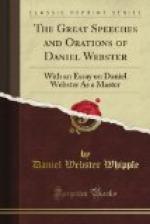This fearful concatenation of circumstances puts him to an account. He was a conspirator. He had entered into this plan of murder. The murder is committed, and he is known to have been within three minutes’ walk of the place. He must account for himself, He has attempted this, and failed. Then, with all these general reasons to show he was actually in Brown Street, and his failures in his alibi, let us see what is the direct proof of his being there. But first, let me ask, is it not very remarkable that there is no attempt to show where Richard Crowninshield, Jr. was on that night? We hear nothing of him. He was seen in none of his usual haunts about the town. Yet, if he was the actual perpetrator of the murder, which nobody doubts, he was in the town somewhere. Can you, therefore, entertain a doubt that he was one of the persons seen in Brown Street? And as to the prisoner, you will recollect, that, since the testimony of the young men has failed to show where he was on that evening, the last we hear or know of him, on the day preceding the murder, is, that at four o’clock, P.M., he was at his brother’s in Wenham. He had left home, after dinner, in a manner doubtless designed to avoid observation, and had gone to Wenham, probably by way of Danvers. As we hear nothing of him after four o’clock, P.M., for the remainder of the day and evening; as he was one of the conspirators; as Richard Crowninshield, Jr. was another; as Richard Crowninshield, Jr. was in town in the evening, and yet seen in no usual place of resort,—the inference is very fair, that Richard Crowninshield, Jr. and the prisoner were together, acting in execution of their conspiracy. Of the four conspirators, J.J. Knapp, Jr. was at Wenham, and George Crowninshield has been accounted for; so that if the persons seen in Brown Street were the murderers, one of them must have been Richard Crowninshield, Jr., and the other must have been the prisoner at the bar.
Now, as to the proof of his identity with one of the persons seen in Brown Street, Mr. Mirick, a cautious witness, examined the person he saw, closely, in a light night, and says that he thinks the prisoner at the bar is the person; and that he should not hesitate at all, if he were seen in the same dress. His opinion is formed partly from his own observation, and partly from the description of others. But this description turns out to be only in regard to the dress. It is said, that he is now more confident than on the former trial. If he has varied in his testimony make such allowance as you may think proper. I do not perceive any material variance. He thought him the same person, when he was first brought to court, and as he saw him get out of the chaise. This is one of the cases in which a witness is permitted to give an opinion. This witness is as honest as yourselves, neither willing nor swift; but he says, he believes it was the man. His words are, “This is my opinion “; and this opinion




